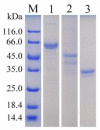The Characterization and Modification of a Novel Bifunctional and Robust Alginate Lyase Derived from Marinimicrobium sp. H1
- PMID: 31547564
- PMCID: PMC6835848
- DOI: 10.3390/md17100545
The Characterization and Modification of a Novel Bifunctional and Robust Alginate Lyase Derived from Marinimicrobium sp. H1
Abstract
Alginase lyase is an important enzyme for the preparation of alginate oligosaccharides (AOS), that possess special biological activities and is widely used in various fields, such as medicine, food, and chemical industry. In this study, a novel bifunctional alginate lyase (AlgH) belonging to the PL7 family was screened and characterized. The AlgH exhibited the highest activity at 45 °C and pH 10.0, and was an alkaline enzyme that was stable at pH 6.0-10.0. The enzyme showed no significant dependence on metal ions, and exhibited unchanged activity at high concentration of NaCl. To determine the function of non-catalytic domains in the multi-domain enzyme, the recombinant AlgH-I containing only the catalysis domain and AlgH-II containing the catalysis domain and the carbohydrate binding module (CBM) domain were constructed and characterized. The results showed that the activity and thermostability of the reconstructed enzymes were significantly improved by deletion of the F5/8 type C domain. On the other hand, the substrate specificity and the mode of action of the reconstructed enzymes showed no change. Alginate could be completely degraded by the full-length and modified enzymes, and the main end-products were alginate disaccharide, trisaccharide, and tetrasaccharide. Due to the thermo and pH-stability, salt-tolerance, and bifunctionality, the modified alginate lyase was a robust enzyme which could be applied in industrial production of AOS.
Keywords: PL7 family; alginate lyase; alginate oligosaccharides; bifunctional; robust enzyme.
Conflict of interest statement
The authors declare no conflict of interest.
Figures








Similar articles
-
Biochemical Characteristics and Variable Alginate-Degrading Modes of a Novel Bifunctional Endolytic Alginate Lyase.Appl Environ Microbiol. 2017 Nov 16;83(23):e01608-17. doi: 10.1128/AEM.01608-17. Print 2017 Dec 1. Appl Environ Microbiol. 2017. PMID: 28939598 Free PMC article.
-
Identification and Characterization of a New Cold-Adapted and Alkaline Alginate Lyase TsAly7A from Thalassomonas sp. LD5 Produces Alginate Oligosaccharides with High Degree of Polymerization.Mar Drugs. 2022 Dec 22;21(1):6. doi: 10.3390/md21010006. Mar Drugs. 2022. PMID: 36662179 Free PMC article.
-
Characterization of a Novel PolyM-Preferred Alginate Lyase from Marine Vibrio splendidus OU02.Mar Drugs. 2018 Aug 22;16(9):295. doi: 10.3390/md16090295. Mar Drugs. 2018. PMID: 30135412 Free PMC article.
-
Alginate derived functional oligosaccharides: Recent developments, barriers, and future outlooks.Carbohydr Polym. 2021 Sep 1;267:118158. doi: 10.1016/j.carbpol.2021.118158. Epub 2021 May 7. Carbohydr Polym. 2021. PMID: 34119132 Review.
-
Recent advances in the production, properties and applications of alginate oligosaccharides - a mini review.World J Microbiol Biotechnol. 2023 May 24;39(8):207. doi: 10.1007/s11274-023-03658-5. World J Microbiol Biotechnol. 2023. PMID: 37221433 Review.
Cited by
-
Cloning, Secretory Expression and Characterization of a Unique pH-Stable and Cold-Adapted Alginate Lyase.Mar Drugs. 2020 Apr 1;18(4):189. doi: 10.3390/md18040189. Mar Drugs. 2020. PMID: 32244721 Free PMC article.
-
Bacterial alginate metabolism: an important pathway for bioconversion of brown algae.Biotechnol Biofuels. 2021 Jul 18;14(1):158. doi: 10.1186/s13068-021-02007-8. Biotechnol Biofuels. 2021. PMID: 34275475 Free PMC article. Review.
-
Multi-Functional Alginate Lyase AlgVR7 from Vibrio rumoiensis: Structural Insights and Catalytic Mechanisms.Mar Drugs. 2025 Mar 13;23(3):124. doi: 10.3390/md23030124. Mar Drugs. 2025. PMID: 40137310 Free PMC article.
-
Sustainable Production of Ulva Oligosaccharides via Enzymatic Hydrolysis: A Review on Ulvan Lyase.Foods. 2024 Sep 5;13(17):2820. doi: 10.3390/foods13172820. Foods. 2024. PMID: 39272585 Free PMC article. Review.
-
Characterization of a Novel Polysaccharide Lyase Family 5 Alginate Lyase with PolyM Substrate Specificity.Foods. 2022 Nov 6;11(21):3527. doi: 10.3390/foods11213527. Foods. 2022. PMID: 36360141 Free PMC article.
References
-
- Inoue A. Characterization of PL-7 Family Alginate Lyases from Marine Organisms. Methods Enzymol. 2018;605:499–524. - PubMed
MeSH terms
Substances
LinkOut - more resources
Full Text Sources
Other Literature Sources
Miscellaneous

